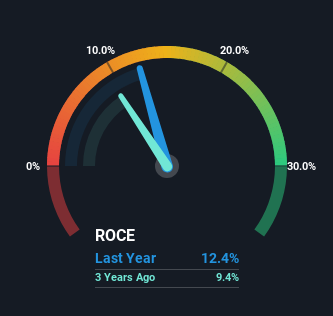Beijing Tieke Shougang Rail Way-Tech's (SHSE:688569) Returns On Capital Not Reflecting Well On The Business
What trends should we look for it we want to identify stocks that can multiply in value over the long term? In a perfect world, we'd like to see a company investing more capital into its business and ideally the returns earned from that capital are also increasing. Ultimately, this demonstrates that it's a business that is reinvesting profits at increasing rates of return. In light of that, when we looked at Beijing Tieke Shougang Rail Way-Tech (SHSE:688569) and its ROCE trend, we weren't exactly thrilled.
What Is Return On Capital Employed (ROCE)?
For those that aren't sure what ROCE is, it measures the amount of pre-tax profits a company can generate from the capital employed in its business. The formula for this calculation on Beijing Tieke Shougang Rail Way-Tech is:
Return on Capital Employed = Earnings Before Interest and Tax (EBIT) ÷ (Total Assets - Current Liabilities)
0.12 = CN¥392m ÷ (CN¥3.8b - CN¥614m) (Based on the trailing twelve months to December 2023).
Thus, Beijing Tieke Shougang Rail Way-Tech has an ROCE of 12%. In absolute terms, that's a satisfactory return, but compared to the Machinery industry average of 6.1% it's much better.
View our latest analysis for Beijing Tieke Shougang Rail Way-Tech

Above you can see how the current ROCE for Beijing Tieke Shougang Rail Way-Tech compares to its prior returns on capital, but there's only so much you can tell from the past. If you're interested, you can view the analysts predictions in our free analyst report for Beijing Tieke Shougang Rail Way-Tech .
The Trend Of ROCE
When we looked at the ROCE trend at Beijing Tieke Shougang Rail Way-Tech, we didn't gain much confidence. To be more specific, ROCE has fallen from 16% over the last five years. However, given capital employed and revenue have both increased it appears that the business is currently pursuing growth, at the consequence of short term returns. If these investments prove successful, this can bode very well for long term stock performance.
On a side note, Beijing Tieke Shougang Rail Way-Tech has done well to pay down its current liabilities to 16% of total assets. That could partly explain why the ROCE has dropped. Effectively this means their suppliers or short-term creditors are funding less of the business, which reduces some elements of risk. Since the business is basically funding more of its operations with it's own money, you could argue this has made the business less efficient at generating ROCE.
The Bottom Line On Beijing Tieke Shougang Rail Way-Tech's ROCE
In summary, despite lower returns in the short term, we're encouraged to see that Beijing Tieke Shougang Rail Way-Tech is reinvesting for growth and has higher sales as a result. And the stock has followed suit returning a meaningful 40% to shareholders over the last three years. So while investors seem to be recognizing these promising trends, we would look further into this stock to make sure the other metrics justify the positive view.
On a separate note, we've found 2 warning signs for Beijing Tieke Shougang Rail Way-Tech you'll probably want to know about.
While Beijing Tieke Shougang Rail Way-Tech may not currently earn the highest returns, we've compiled a list of companies that currently earn more than 25% return on equity. Check out this free list here.
Mobile Infrastructure for Defense and Disaster
The next wave in robotics isn't humanoid. Its fully autonomous towers delivering 5G, ISR, and radar in under 30 minutes, anywhere.
Get the investor briefing before the next round of contracts
Sponsored On Behalf of CiTechValuation is complex, but we're here to simplify it.
Discover if Beijing Tieke Shougang Rail Way-Tech might be undervalued or overvalued with our detailed analysis, featuring fair value estimates, potential risks, dividends, insider trades, and its financial condition.
Access Free AnalysisHave feedback on this article? Concerned about the content? Get in touch with us directly. Alternatively, email editorial-team (at) simplywallst.com.
This article by Simply Wall St is general in nature. We provide commentary based on historical data and analyst forecasts only using an unbiased methodology and our articles are not intended to be financial advice. It does not constitute a recommendation to buy or sell any stock, and does not take account of your objectives, or your financial situation. We aim to bring you long-term focused analysis driven by fundamental data. Note that our analysis may not factor in the latest price-sensitive company announcements or qualitative material. Simply Wall St has no position in any stocks mentioned.
About SHSE:688569
Beijing Tieke Shougang Rail Way-Tech
Beijing Tieke Shougang Rail Way-Tech Co., Ltd.
Flawless balance sheet with solid track record.
Market Insights
Weekly Picks

Early mover in a fast growing industry. Likely to experience share price volatility as they scale


A case for CA$31.80 (undiluted), aka 8,616% upside from CA$0.37 (an 86 bagger!).


Moderation and Stabilisation: HOLD: Fair Price based on a 4-year Cycle is $12.08
Recently Updated Narratives


An amazing opportunity to potentially get a 100 bagger

Amazon: Why the World’s Biggest Platform Still Runs on Invisible Economics

Sunrun Stock: When the Energy Transition Collides With the Cost of Capital
Popular Narratives


MicroVision will explode future revenue by 380.37% with a vision towards success


Crazy Undervalued 42 Baggers Silver Play (Active & Running Mine)


NVDA: Expanding AI Demand Will Drive Major Data Center Investments Through 2026
Trending Discussion


